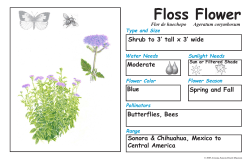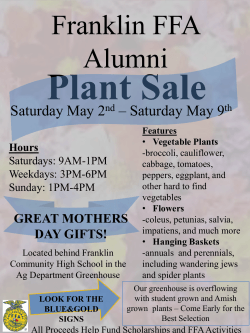
Impatiens flyer
Impatiens Genus facts Non-Native Impatiens Impacts Species of the genus Impatiens are commonly known as jewelweeds, touch-me-nots, snapweeds, or balsams. The non-native Impatiens herein are invasive in certain habitats in the PNW. Plants are considered invasive when they cause harm to public health, agriculture, recreation, native plants and animals, or property. Pacific Northwest (PNW) Impatiens species are annuals, flowering from June to October. Leaves are usually long and serrated. Species are best identified by their flowers. They can also produce tiny and unassuming selfpollinating flowers in leaf axils. Impatiens seeds are dispersed by a spring-like mechanism that shoots seeds up to several feet away. IMPATIENS OF THE PACIFIC NORTHWEST Non-native Impatiens can outcompete native species to form monocultures, reducing species diversity. Impatiens that form dense populations (such as I. capensis) outcompete riparian vegetation, leaving bare ground when they die back before fall and winter rains, when vegetation is needed most. This drastically increases erosion and runoff, reducing water quality. Some non-native Impatiens are also known to interfere with important soil fungi interactions beneficial to the roots of saplings, reducing root mass and fitness in tree populations (Ruckli 2014). Best Management Practices Manual: Hand-pulling is effective and easy for small patches. Volunteer assistance is a cost-effective option for this approach. Mechanical: Repeated mowing and weed whacking works for large infested areas. Act early in the year before plants go to seed. Chemical: Glyphosate products are effective, but can be detrimental to neighboring plants and waterways; use in combination with above practices. Follow all label indications when applying. Check if a license is necessary before spraying. Ruckli, R., HP. Rusterholz, & B. Baur. 2014. Forest Ecology and Management, 318: 285–293. Zika, P. 2006. Novon, 16: 443-448. King County Noxious Weed Control Program. 2010. Policeman’s helmet: best management practices. Species Distributions: OSU Herbarium, UI Stillinger Herbarium, UW Herbarium. Consortium of Pacific Northwest Herbaria (www.pnwherbaria.org, 11/30/14) Front image: King County Noxious Weed Control Program. 2010. Center, back, and I. bicolor images: Maze, D. 2014. Other species images: Zika, P. 2009. For more information contact Dominic Maze: dominic.maze@portlandoregon.gov or dominicmaze@gmail.com www.portlandonline.com/bes/invasives This brochure was made possible by the City of Portland Bureau of Environmental Services (D. Maze and L. Karr), and the efforts of Dr. Catherine De Rivera’s students at Portland State University. May be reproduced for noncommercial purposes and without written consent. 2014 Impatiens glandulifera Identification of native and nonnative Impatiens Harmful impacts of non-native Impatiens and why they are invasive Management techniques for the removal of non-native Impatiens. Policeman’s Helmet (I. glandulifera) *Non-Native* Flowers purple to pink with small spur, sometimes with red spots. Flower length: 1¼ - 1½ in. Height: 3 - 7 ft. Bicolor Touch-me-not (I. bicolor) *Non-Native* Flowers yellow and purple with hooked spur, often with red veins. Known in one watershed in Multnomah Co. Flower length: ~1½ in. Height: 1 - 3 ft. Spurless Touch-me-not (I. ecornuta) *Native* Flowers pale yellow to orange without spots or spur. Flower length: ⅓ - ¾ in. Height: 1⅓ - 3⅓ ft. Smallflower Touch-me-not (I. parviflora) *Non-Native* Flowers small, white to pale yellow with orange patch in mouth and straight spur. Flower length: ½ - ¾ in. Height: ¾ - 4 ft. Spotted Jewelweed (I. capensis) *Non-Native* Flowers yellow or orange and rarely white, with dark orange or red spots and a hooked spur. Flower length: ¾ - 1 in. Height: ¾ - 6 ft. Western Touch-me-not (I. noli-tangere) *Native* Flowers yellow, sometimes with red spots on tube, and a gradually tapered hooked spur. Flower length: 1 - 1½ in. Height: 1 - 2⅓ ft. Balfour’s Balsam (I. balfourii) *Non-Native* Flowers white and purple/ pink with yellow dots and a gradually tapered straight spur. Flower length: ¾ - 1¾ in. Height: 1⅓ - 4 ft. Pacific Jewelweed (I. x pacifica) Hybrid: Native (I. ecornuta) & Non-Native (I. capensis) Flowers yellow to orange, variable in form with spotted spurless and unspotted spurred forms possible. Flower length: ¼ - ¾ in. Height: up to 7 ft. Orange Touch-me-not (I. aurella) *Native* Flowers yellow to orange with hooked spurs, sometimes with orange spots on petals. Flower length: ⅓ - ½ in. Height: ½ - 3⅓ ft. *Where this hybrid occurs, pull only I. capensis individuals (the non-native parent)!
© Copyright 2025









